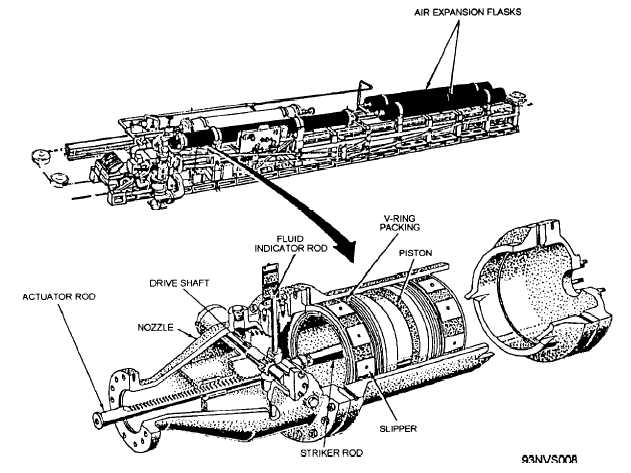Figure 3-8.—The Mk 7 accumulator.
metal-to-metal wear between the piston and the
accumulator wall. An eyebolt is provided on the air
side of the piston to aid in removing the piston from
the accumulator when maintenance is required. The
fluid side of the piston has a striker rod that
actuates a fluid-level indicator located in the
accumulator nozzle.
The fluid-level indicator has a drive shaft that
extends through the nozzle from side to side and is
secured in place by flanges and bolts. O-rings
provide a seal against leakage of fluid around the
drive shaft. Gears are secured onto the shaft inside
the nozzle. These gears mate with teeth on the
actuator rod, which extends fore and aft in the
nozzle, and the fluid-indicator rod, which is vertical
and extends through the top of the nozzle. An
O-ring prevents leakage around the indicator rod.
When the striker rod on the piston makes contact
with the actuator rod, the drive shaft rotates,
causing the indicator rod to move down. See figure
3-8.
An indicator plate is
nozzle.
The plate has
BATTERY, and FILL.
mounted on top of the
the readings DRAIN,
The indicator rod is a
differential rod; and any time the piston striker rod
is not in contact with the actuator rod, accumulator
pressure working on the differential area of the
indicator rod will cause the indicator rod to rise to
the DRAIN position.
NOTE
The engine crosshead must always be in
its BATTERY position when the fluid level
of the arresting engine is checked.
FLUID REPLENISHMENT SYSTEM
In any hydraulic system, small amounts of fluid
are lost due to leakage. Fluid also contracts when
cold and expands when hot. To compensate for
leakage and expansion or contraction of the
hydraulic fluid in the hydraulic system of the Mk 7
3-13


